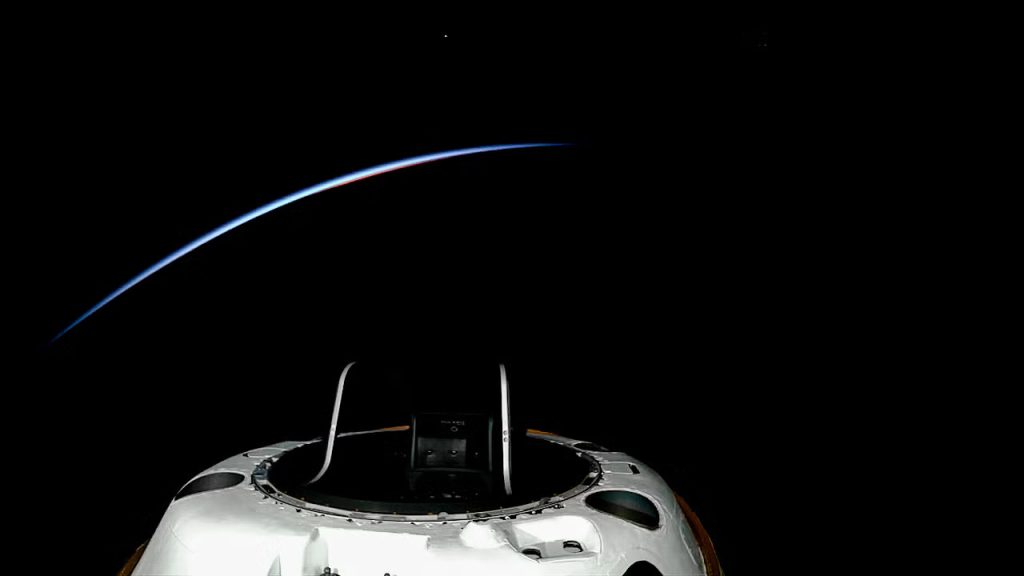SpaceX’s Polaris Dawn mission achieved a historic milestone early Tuesday, launching a four-person civilian crew into orbit and reaching the highest altitude around Earth since NASA’s Apollo missions. The SpaceX Crew Dragon spacecraft, carrying the crew, attained a peak altitude of 1,400.7 kilometers (870 miles) at 9:19 p.m. ET on Tuesday, surpassing the record set by NASA’s Gemini 11 mission in 1966, which reached 853 miles (1,373 kilometers).
This accomplishment marks the farthest any human has traveled since the final Apollo mission in 1972 and the farthest into space a woman has ever ventured. The Polaris Dawn mission is designed to push the boundaries of commercial space travel and test technologies for future deep-space excursions.
In a social media update Tuesday evening, the Polaris Dawn program confirmed that the crew enjoyed their first on-orbit meals and engaged in the mission’s initial science and research activities, including testing Starlink, SpaceX’s network of internet-beaming satellites. This test is crucial for evaluating Starlink’s potential for in-space connectivity, a capability that could be vital for future missions.
Despite the milestone, the mission’s most challenging tasks lie ahead. As early as Thursday morning, the Polaris Dawn team, comprising Shift4 Payments CEO Jared Isaacman, former US Air Force pilot Scott “Kidd” Poteet, and SpaceX engineers Anna Menon and Sarah Gillis, will attempt the first commercial spacewalk. This groundbreaking event is scheduled to occur while the crew is orbiting about 435 miles (700 kilometers) above Earth.
During the spacewalk, the Crew Dragon capsule will be depressurized, and a circular hatch will be opened, exposing the crew to the vacuum of space. Two crew members, Gillis and Isaacman, will exit the spacecraft for approximately two hours. The crew will be protected by SpaceX’s new Extravehicular Activity (EVA) suits, designed and developed in just 2.5 years, a remarkably quick timeline by aerospace standards.
The crew is currently undergoing a lengthy “pre-breathe” process to prepare their bodies for the spacewalk. This process involves slowly purging nitrogen from the crew members’ blood to prevent decompression sickness, a potentially fatal illness similar to what scuba divers may face if they surface too quickly. Unlike the rapid pre-breathing process on the International Space Station, which takes only a couple of hours, the Polaris Dawn crew’s pre-breathe routine will last about 45 hours.
“What is really cool about this (pre-breathing) profile is it actually, in many ways, is much less risky than what the standard is on the space station,” Gillis said. “It’s like opening a can of soda pop — and you want to open the can (and have) none of the bubbles to come out because the pressure outside of the can is equal to what’s inside.”
By lowering the pressure inside the Crew Dragon and putting on their spacesuits just as the ambient pressure equals the suit pressure, the crew members can better mitigate any risk of unwanted bubbles.
The biggest challenge will come after the spacewalk concludes: closing the hatch on board the Crew Dragon capsule, restoring normal pressurization, and safely returning to Earth.
You should be nervous about (this mission),” former NASA astronaut and SpaceX adviser Garrett Reisman told the media in August. “Anytime you try something for the first time there are significant risks. I’ll feel much better when they are back inside with the hatch closed and latched.”











Pink Withney I’m often to blogging and i really appreciate your content. The article has actually peaks my interest. I’m going to bookmark your web site and maintain checking for brand spanking new information.
UEGxkJgCwHedPN